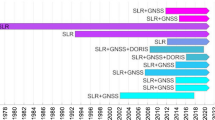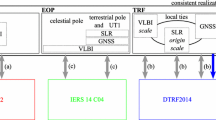Abstract
Accurate relative positioning via dynamic satellite methods is a complicated process. In an attempt to simplify this process a semidynamic method has been investigated in a real data environment. In this method quasi-simultaneous observations from pairs of stations are transformed to Simultaneous Range Differences(SRD's). With this transformation it is anticipated to reduce the effects of orbital and observational residual biases and, therefore, to obtain baselines the accuracy of which is less sensitive to the overall orbital accuracy and yet compatible to that of the observations. Using laser range observations to Lageos collected during theMERIT Main Campaign, baselines have been estimated via both theSRD and the geometric methods. Baselines estimated via the geometric method are independent of orbital errors and any inconsistencies affecting the implementation of the Terrestrial Reference Frame, and therefore they have been used in the present study as standards of comparison. From this comparison it was concluded that for baselines of regional extent, theSRD method is very efficient and at least as accurate as the more complex dynamic methods.
Similar content being viewed by others
References
G. AFONSO, F. BARLIER, C. BERGER, F. MIGNARD, J.J. WALCH (1985): “Reassessment of the Charge and Neutral Drag of Lageos and Its Geophysical Implications”,J. of Geophys. Res., Vol. 90, No. B11, pp. 9381–9398.
W. BAARDA (1968): “A Testing Procedure for Use in Geodetic Networks”. Publications on Geodesy, New Series, Vol. 2, No. 5, Netherlands Geodetic Commission, Delft.
G. BLAHA (1971) “Investigations of Critical Configurations for Fundamental Range Networks”. Dept. of Geodetic Science, Rep. 150, Ohio State Univ., Columbus.
B. CARNAHAN, H.A. LUTHER, J.O. WILKES (1969)Applied Numerical Methods. Wiley and Sons, New York.
D.C. CHRISTODOULIDIS, D.E. SMITH, S.M. KLOSKO, M.H. TORRENCE, P.J. DUNN (1985): “A GSFC Alternative to the SLR MERIT Standards” Proc. of the International Conf on Earth Rotation and the Terrestrial Reference Frame, Vol. 2, Dept. of Geodetic Science and Surveying, Ohio, State Univ., Columbus.
G.C. DEDES (1987): “Baseline Estimation from Simultaneous Satellite Laser Tracking”. Dept. of Geodetic Science and Surveying, Rep. 384, Ohio State Univ., Columbus.
J. DIAMANTE, R. WILLIAMSON (1972): “Error Models for Solid Earth and Ocean Tidal Effects in Satellite Systems Analysis”. Wolf Research and Development Corp., Greenbelt, Maryland.
J.W. MARINI C.W. MURRAY, Jr. (1973): “Correction of Laser Range Tracking Data for Atmospheric Refraction at Elevation Angles Above 10 Degrees”. NASA Technical Rep. X-591-73-351, NASA/Goddard Space Flight Center, Greenbelt, Maryland.
W. MELBOURNE, R. ANDERLE, M. FEISSEL, R. KING, D. McCARTHY, D. SMITH, B. TAPLEY, R. VICENTE (1983): “Project MERIT Standards”. U.S. Naval Observatory Circular No. 167, Washington, D.C. 20390.
H. MONTAG (1985): “Zur Effektivität verschiedener satellitengeodätischer Messmethoden für die Bestimmung des Erderotationsvektors”. Sonderdruck aus Vermessungstechnik, Heft 7.
H. MONTAG, G. GENDT, R. DIETRICH, K. KURTH (1985): “Investigation of Polar Motion and the Length of Day by Means of SLR Data of the MERIT Campaign”. Proc of the International Conf. on Earth Rotation and the Terrestrial Reference Frame, Dept. of Geodetic Science and Surveying, Ohio State Univ., Columbus.
I.I. MUELLER (1964):Introduction to Satellite Geodesy. Ungar Publ., New York.
I.I. MUELLER, B.H.W. van GELDER, M. KUMAR (1975): “Error Analysis for the Proposed Close Grid Geodynamic Satellite Measurement System (CLOGEOS)”. Dept. of Geodetic Science. Rep. 230, Ohio State Univ., Columbus.
P. MUSEN (1973): “A Semi-Analutical Method of Computation of Oceanic Tidal Perturbations in the Motion of Artificial Satellites”. X-590-73-190. NASA/Goddard Space Flight Center, Greenbelt, MD.
E.C. PAVLIS (1979): “Error Analysis for a Spaceborne Laser Ranging System”. Dept. of Geodetic Science Rep. 290, Ohio State Univ., Columbus.
E.C. PAVLIS (1982): “On the Geodetic Applications of Simultaneous Range-Differencing to LAGEOS”. Dept. of Geodetic Science and Surveing. Rep. 338, Ohio State Univ., Columbus.
E. C. PAVLIS, I.I. MUELLER (1983): “The Effect of Earth Orientation Errors in Baseline Determination”,Bull. Géodésique, Vol. 57, No. 3, pp. 273–282.
D.P. RUBINCAM, N.R. WEISS (1985): “The Orbit of LAGEOS and Solar Eclipses”,J. of Geophys. Res., Vol. 90, No. B11, pp. 9399–9402.
C.R. SCHWARZ (1969): “The Use of Short Arc Orbital Constraints in the Adjustment of Geodetic Satellite Data”. Dept. of Geodetic Science, Rep. 118, Ohio State Univ. Columbus.
D.E. SMITH, D.C. CHRISTODOULIDIS, R. KOLENKIEWICZ, P.J. DUNN, S.M. KLOSKO, M.H. TORRENCE, S. FRICKE, S. BLACKWELL (1985): “A Global Geodetic Reference Frame from Lageos Ranging (SL5.1AP)”,J. of Geophys. Res., Vol. 90, No. B11, pp. 9221–9233.
D.E. SMITH, R. KOLENKIEWICZ, P.J. DUNN, E.C. PAVLIS, M.K. TORRENCE, S.M. KLOSKO, J.W. ROBBINS, R.G. WILLIAMSON, S. FRICKE (1988): “Lageos Station Positioning at Quarterly Time Resolution”.Transactions, American Geophysical Union, Vol. 69, No. 16.
B.D. TAPLEY, R.J. EANES, B.E. SCHUTZ (1985): “UT/CSR Analysis of Earth Rotation from Lageos SLR Data”. Proc. of the International Conf on Earth Rotation and the Terrestrial Reference Frame, Vol. 1, Dept. of Geodetic Science and Surveying, Ohio State Univ., Columbus.
E. TSIMIS (1973): “Critical Configurations (Determinantal Loci) for Range and (Range-Difference Satellite Networks”. Dept. of Geodetic Science, Rep. 191, Ohio State Univ., Columbus.
B.H.W. Van GELDER (1978): “Estimability and Simple Dynamical Analysis of Range (Range-Rate and Range-Difference) Observations to Artificial Satellites”. Dept. of Geodetic Science, Rep. 284, Ohio State Univ., Columbus.
G. VEIS (1960): “Geodetic Uses of Artificial Satellites”.Smithsonian Contrib. to Astrophys., Vol. 3, No. 9.
G. A. WILKINS, I.I. MUELLER (1986) “On the Rotation of the Earth and the Terrestrial Reference System”.Bull. Géodésique, Vol. 60, No. 1.
Author information
Authors and Affiliations
Rights and permissions
About this article
Cite this article
Dedes, G.C., Mueller, I.I. Baseline estimation with semidynamic and geometric satellite methods. Bull. Geodesique 63, 99–114 (1989). https://doi.org/10.1007/BF02519145
Received:
Accepted:
Issue Date:
DOI: https://doi.org/10.1007/BF02519145




